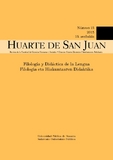Modelos de secuenciación en la didáctica de las lenguas extranjeras
Palabras clave:
Secuenciación didáctica, posmétodo, estrategias didácticasResumen
Este ensayo tiene como objeto la representación de los modelos de secuenciación más notables en la didáctica de las lenguas extranjeras. Empezamos con la secuenciación didáctica de tipo PPP (Presentation, Practice, Production), que tuvo una especial difusión a través del método estructural. A continuación consideramos un modelo de secuenciación que se reconoce como compatible con un enfoque comunicativo: el modelo de la unidad didáctica, planteado por autores italianos (Freddi 1979, 1994, Porcelli, 1994; Balboni, 1994, 2008, 20082; Vedovelli 2002). Seguimos con el modelo de la Deep-end Strategy, formulado por Johnson (1980) y reformulado por Harmer (2001). Finalmente describimos la didáctica por threads, de Woodward (1998), la cual, en nuestra opinión, encaja con la concepción estético-narrativa de la didáctica avanzada de Thornbury (1999a).
Descargas
Citas
Balboni, P. E. (1994): Didattica dell’italiano a stranieri, Roma, Bonacci.
Balboni, P. E. (1999): Tecniche didattiche per l’educazione linguistica, Torino, Utet.
Balboni, P. E. (2008): Fare educazione linguistica, Torino, Utet.
Balboni, P. E. (20082): Le sfide di Babele. Insegnare le lingue nelle società complesse, Torino, Utet.
Breen, M.; Candlin, C. (1987): «Which Materials? A Consumer’s and Designer’s Guide», en L. E. L. Sheldon (ed.), Textbook and Materials: Problems in Evaluation and Development.
ELT Documents (126), London, Modern English Publications and the London British Council, pp. 13-28.
Brumfit, C. (1979): «“Communicative” Language Teaching: An Educational Perspective», en C. Brumfit y K. Johnson (eds.), The Communicative Approach to Language Teaching, Oxford, OUP, pp. 183-191.
Bruner, J. (1985): «Narrative and Paradigmatic Modes of Thought», en E.Eisner (ed.), Learning and Teaching the Ways of Knowing, Chicago, University of Chicago Press.
Byrne, D. (1986): Teaching Oral English, London, Longman.
Bygate, M.; Samuda, V. (2009): «Creating Pressure in Task Pedagogy: The Joint Roles of Field, Purpose and Engagement within the Interactional Approach», en A. Mackey y
C. Polio (eds.), Multiple Perspectives on Interaction, New York, Routledge, pp. 90-116.
Criado, R. (2009): Patterns of Activity Sequencing in the Teaching of English as a Foreign Language and their Effects on Learning: A Quasi-Experimental Study, Universidad de Murcia,Tesis doctoral.
Criado, R. (2010): «The Impact of Activity Sequencing on the Differences between ELT Methods: A Critical Analysis of Sample Units», Porta Linguarum, pp. 14, 7-28.
Criado, R. (2013): «A Critical Review of the Presentation-Practice-Production Model (PPP) in Foreign Language Teaching», en R. Monroy (ed.), Homenaje a Francisco Gutiérrez Díez, Murcia, Editorial Universitaria, pp. 97-115.
Danesi, M. (1988): Neurolinguistica e Glottodidattica, Torino, Petrini.
Dörnyei, Z. (2001): Motivational Strategies in the Language Classroom, Cambridge, CUP.
Fiorise, L. (2015): «Balboni: l’emozione è la porta per entrare in una mente», La Gazzetta del Sud Africa, 31 luglio 2015.
Forster, E. M. (1990): Aspects of the Novel, London, Penguin.
Freddi, G. (1979): Didattica delle lingue moderne, Bergamo, Minerva Italica.
Gass, S. M. (2003): «Input and Interaction», en C. Doughty; M. C. Long (eds.), The Handbook of Second Language Acquisition, Oxford, Blackwell, pp. 224-255,
Harmer, J. (1996): «Is PPP Dead?», Modern English Teacher, 5, 2, pp. 7-14.
Harmer, J. (20013): The Practice of ELT, London, Longman.
Hedge, T. (2000): Teaching and Learning in the Language Classroom, Oxford, OUP.
Howard-Jones, P. (2009): Introducing Neuroeducational Research: Neuroscience, Education and the Brain from Contexts to Practice, London, Routledge.
Johnson, K. (1980): «Making Drills Communicative», Modern English Teacher, 7, 4, pp. 12-16.
Johnson, K.; Jackson S. (2006): «Comparing Language Teaching and Other-skill Teaching: Has the Language Teacher Anything to Learn?», System, 34, pp. 532-546.
Johnstone, K. (1981): Impro, London, Bloomsbury.
Krashen, S. D. (1981): Second Language Acquisition and Second Language Learning, Oxford, Pergamon,
Krashen, S. D. (1982): Principles and Practice in Second Language Acquisition, Oxford, Pergamon.
Krashen, S. D. (1985): The Input Hypothesis. Issues and Implications, New York, Longman.
Lewin, K. (1936): Principles of Topological Psychology, New York, McGraw-Hill.
Ovskiankina, M. (1928): «Die Wiederaufnahme unterbrochener Handlungen», Psychologische Forschung, 11, pp. 302-379.
Porcelli, G. (1994): Principi di glottodidattica, Brescia, La Scuola.
Read, C. (1985): «Presentation, Practice and Production at a Glance», en A. Matthew, M. Spratt y L. Dangerfield (eds.), At the Chalkface, London, Addison Wesley, p. 17.
Sawyer, K. (2004): «Creative Teaching: Collaborative Discussion as Disciplined Improvisation», Educational Researcher, 2, pp. 12-20.
Sawyer, K. (2011): «What Makes Good Teachers Great? An Artful Balance of Structure and Improvisation», en K. Sawyer (ed.), Structure and Improvisation in Creative Teaching, Cambridge, CUP, pp. 1-24.
Schmidt, R.; Frota, S. (1986): «Developing Basic Conversational Ability in a Foreign Language: A Case Study of an Adult Learning Portuguese», en R. R. Day (ed.), Talking to
Learn, Rowley, MA, Newbury House, pp. 237-326.
Scrivener, J. (1994): «PPP and After», The Teacher Trainer, 8, 1, pp. 15-16.
Skehan, P. (1989): Individual Differences in Second Language Learning, London, Arnold.
Skehan, P. (1998): A Cognitive Approach to Language Learning, Oxford, OUP.
Stevick, E. (1990): Humanism in Language Learning. A Critical Perspective, Oxford, OUP.
Taylor, J. (2001): The Minimax Teacher, Peaslake, Delta.
Thornbury, S. (1999ba): «Lesson Art and Design», ELT Journal, 53, 1, pp. 4-11.
Thornbury, S. (1999b): How to teach grammar, Harlow, Pearson.
Thornbury, S. (2000): «A Dogma for EFL», IATEFL Issues, 153. 2.
Thornbury, S. <http://www.teaching-unplugged.com/dogmaarticle.html>
Thornbury, S. (2013): «P is for PPP» <http://www.youtube.com/watch?v=EddmOr-b57g>.
Torresan, P. (2009): «Polirappresentazionalità e circolarità nella didattica dell’italiano», Zeitschrift für Romanische Sprachen und ihre Didaktik, 3, 2, pp. 81-90.
Vedovelli, M. (2002): Guida all’italiano per stranieri. La prospettiva del Quadro comune europeo per le lingue, Roma, Carocci.
Willis, D. (2004): «Towards a New Methodology», English Language Teaching Professionals, 33, pp. 4-6.
Willis, D.; Willis, J. (2007): Doing Task-based Teaching, Oxford, OUP.
Willis, J. (1996): A Framework for Task-based Learning, Essex, Addison Wesley Longman.
Willis, J. (1994): «Preaching What We Practice, Training What We Teach: Task-based Language Learning as an Alternative to PPP», The Teacher Trainer, 8, 1, pp. 17-20.
Woodward, T. (1993): «Changing the Basis of Pre-service TEFL Training in the UK», IATEFL TT SIG Newsletter, 13, pp. 3-5.
Woodward, T. (2001): Planning Lessons and Courses, Cambridge, CUP.
Woodward, T.; Lindstromberg, S. (1998): Planning Lesson to Lesson, Harlow,Longman.
Descargas
Publicado
Cómo citar
Número
Sección
Licencia
Todos los artículos son publicados bajo una licencia de uso y distribución Creative Commons (BY-NC-ND 4.0). A cada artículo se le asignará un identificador DOI.
Los autores conservan los derechos de autor y conceden a la revista el derecho de la primera publicación. Los autores podrán establecer acuerdos adicionales para la distribución no exclusiva de la versión de la obra publicada en la revista (por ejemplo, situarlo en un repositorio institucional), con un reconocimiento de su publicación inicial en esta revista. Los trabajos podrán subirse a repositorios institucionales inmediatamente tras la publicación de la revista.
Asimismo, se permite y se anima a los autores a difundir sus trabajos electrónicamente (por ejemplo, en repositorios institucionales, redes sociales académicas o en su propio sitio web).







